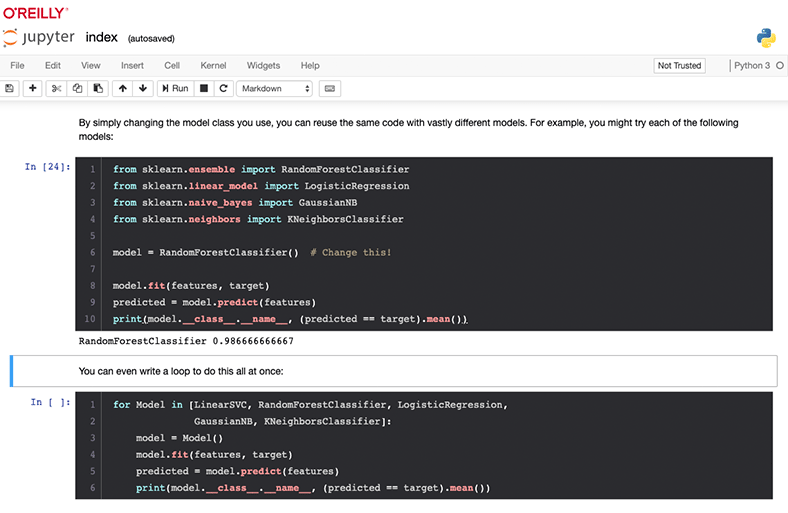Bring Your Learning to Life
Preview: Jupyter Notebooks
Preview: Jupyter Notebooks
For a limited time only, you can preview one of our new premium content formats that will soon require an account upgrade to access. Don’t just learn—do. Apply the skills you’re reading about in real time with interactive Jupyter Notebooks.

Try any one of these seven titles for a limited time only. Let us know what you think, and get ready for more Jupyter enabled content coming soon.
Whirlwind Tour of Python
To tap into the power of Python’s open data science stack—including NumPy, Pandas, Matplotlib, Scikit-learn, and other tools—you first need to understand the syntax, semantics, and patterns of the Python language. This report provides a brief yet comprehensive introduction to Python for engineers, researchers, and data scientists who are already familiar with another programming language.
Learn more
Python Data Science Handbook
Many researchers consider Python a first-class tool due to its libraries for storing, manipulating, and gaining insight from data. Several resources exist for individual pieces of this data science stack, but only with the Python Data Science Handbook do you get them all: IPython, NumPy, Pandas, Matplotlib, Scikit-Learn, and other related tools.
Learn more
Machine Learning with Scikit-Learn: Introduction to Machine Learning
Get up to speed on the basics of ML and how to apply it in scikit-learn, a popular package that contains a collection of tools for machine learning written in Python. You’ll gain an understanding of the data layout expected in scikit-learn and the essential features of scikit-learn’s API, as well as how they can be used together to gain insight from a more complex dataset.
Learn more
Machine Learning with Scikit-Learn: Trees and Forests
Get a conceptual introduction to decision trees and random forests, which can be used to fit complicated datasets without overfitting. You’ll also learn about the term bagging and what it means in a machine learning context and explore examples of decision trees and random forests in scikit-learn.
Learn more
Machine Learning with Scikit-Learn: Support Vector Machines
Take an in-depth look at one of the most powerful classical machine learning techniques: support vector machines (SVMs). You’ll gain a qualitative understanding of the SVM model, an understanding of the concept of kernel methods in machine learning, and see how SVMs can be implemented and used in scikit-learn.
Learn more
Machine Learning with Scikit-Learn: Feature Engineering
Dive into examples of engineering features used in machine learning algorithms, including one-hot encoding for categorical data, frequency-based encoding for textual data, histogram-of-gradient (HOG) features for image data, and more. With this approach, you’ll better understand several common approaches to feature engineering and gain exposure to more examples of Scikit-learn’s API applied to real-world datasets.
Learn more
Machine Learning with Scikit-Learn: Hyperparameters and Model Validation
Get a primer on the concept of model validation and model selection in scikit-learn and learn how to apply a ML model to a set of data with known labels in order to evaluate how well the model works. You’ll also discuss holdout sets, cross-validation, bias and variance, and validation curves.
Learn more